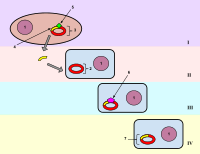
Photo from wikipedia
Abstract This study aims to define the nature (discrete or continuous?) of stress-induced transformation mechanisms in nickel-rich Ti-Ni shape memory alloys with a grain size down to 8 nm. The alloys… Click to show full abstract
Abstract This study aims to define the nature (discrete or continuous?) of stress-induced transformation mechanisms in nickel-rich Ti-Ni shape memory alloys with a grain size down to 8 nm. The alloys were subjected to thermomechanical treatments comprising cold rolling with true strains of e = 0.3, 0.55 and 1.7 and post-deformation annealing in the 300–700 °C temperature range. As a result, nanograined (grain size of 8–17 nm), coarse-grained (grain size of 5–10 μm) and mixed nanograined/nanosubgrained structures were formed in B2-austenite. Firstly, TEM and temperature-variable XRD analyses showed that: (1) a truly (in fact, predominantly) nanograined structure can be obtained only after low-temperature post-deformation annealing of a severely cold-rolled (e = 1.7) alloy; (2) the parent phase state of the thermomechanically treated nickel-rich Ti-Ni alloys is not a single-phase (B2), but a two-phase (B2+R), state. Secondly, in situ X-ray diffraction analyses during tensile deformation showed that: (1) in the case of a nanograined B2-austenite, a reliable separation of the strong multi-component X-ray diffraction profiles in vicinity of the {110}B2 line and, consequently, their use for the assessment of the nature of phase transformation mechanisms, are not feasible; (2) in this situation, relatively weak individual B19′-martensite lines, such as the (110), (11¯2), (022), (200), (032) and (212) lines, may serve as key diffractogram features revealing the nature of phase transformation mechanisms; (3) tracing the evolution of these key lines across the entire path of stress-induced phase transformation unambiguously evidences its discrete (i.e., martensitic) nature in Ti-Ni alloys with hyperfine-grained (down to 8 nm) austenite.
Journal Title: Journal of Alloys and Compounds
Year Published: 2019
Link to full text (if available)
Share on Social Media: Sign Up to like & get
recommendations!